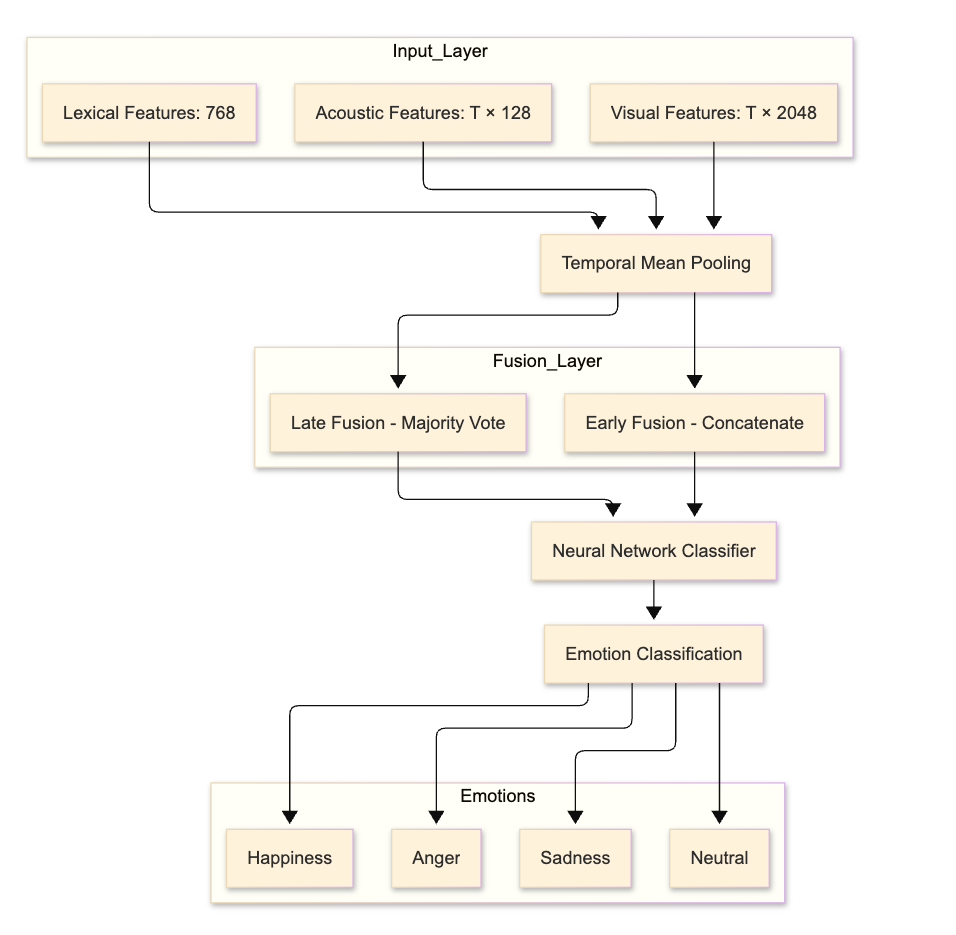Multimodal Emotion Recognition with Feature Fusion
Deep Learning approach for emotion classification using unimodal models and early/late fusion techniques in PyTorch.
Overview
This project implements multimodal emotion recognition on the IEMOCAP dataset, classifying utterances into 4 emotion classes using pre-extracted ResNet visual features, VGGish audio features, and BERT text embeddings.The project focused on comparing different feature fusion strategies and understanding when multimodal approaches outperform single-modality methods.
Dataset
IEMOCAP (Interactive Emotional Dyadic Motion Capture) is a 12‑hour multimodal corpus of dyadic emotional conversations from 10 actors, offering synchronized ResNet‑2048 visual, VGGish‑128 acoustic and BERT‑768 textual features. All features are speaker‑normalized across four emotion classes (Anger, Sadness, Happiness, Neutral) For more details, refer to the IEMOCAP dataset documentation.
Core Challenge: How to effectively combine features from different modalities with different temporal structures.
Model Architecture

- The architecture performs multimodal emotion classification using lexical (BERT), acoustic (VGGish), and visual ( ResNet) features from the IEMOCAP dataset.
- Temporal mean pooling is applied to align modalities, followed by early or late fusion strategies to combine representations.
- A neural network classifier predicts one of four emotion classes: Happiness, Anger, Sadness, or Neutral.
Methodology
My approach follows a systematic three-stage pipeline: unimodal classification, multimodal fusion, and neural network classification.
Stage 1: Unimodal Feature Processing
Each modality is processed independently to establish baseline performance and understand individual modality contributions:
Temporal Pooling for Visual and Acoustic Features:
def temporal_pooling(features, method='mean'):
"""
Reduce temporal dimension using mean pooling
Args:
features: Input features with temporal dimension
method: Pooling method ('mean' or 'max')
"""
if features is None or features.size == 0:
return None
if method == 'mean':
return np.mean(features, axis=0)
elif method == 'max':
return np.max(features, axis=0)
return features
Next, implement unimodal classifiers for each modality using a simple feedforward neural network architecture.Each classifier is trained independently on its respective modality features.
Unimodal Neural Network Architecture:
class ModalityClassifier(nn.Module):
def __init__(self, input_dim, hidden_dim=128, num_classes=4):
super(ModalityClassifier, self).__init__()
self.model = nn.Sequential(
nn.Linear(input_dim, hidden_dim), # First hidden layer
nn.ReLU(), # hidden_dim, hidden_dim // 2), # Second hidden layer (64 neurons)
nn.ReLU(),
nn.Linear(hidden_dim // 2, num_classes) # Output layer (4 emotions)
)
def forward(self, x):
return self.model(x)
Stage 2: Multimodal Fusion Strategies
After establishing unimodal baselines, the next step is to explore different fusion strategies to combine the modalities effectively. This project implements two fusion strategies: early fusion (feature-level) and late fusion (decision-level).
Early Fusion (Feature-Level):
class EarlyFusionModel(nn.Module):
def __init__(self, visual_dim, acoustic_dim, lexical_dim, hidden_dim=256, num_classes=4):
super(EarlyFusionModel, self).__init__()
# Concatenate all feature dimensions
self.combined_dim = visual_dim + acoustic_dim + lexical_dim # 2048 + 128 + 768 = 2944
self.model = nn.Sequential(
nn.Linear(self.combined_dim, hidden_dim),
nn.ReLU(),
nn.Linear(hidden_dim, hidden_dim // 2),
nn.ReLU(),
nn.Linear(hidden_dim // 2, num_classes)
)
def forward(self, x):
return self.model(x)
# Feature concatenation process
def early_fusion_preprocessing(visual_features, acoustic_features, lexical_features):
"""
Concatenate normalized features from all modalities
"""
# Normalize each modality separately
visual_scaler = StandardScaler()
acoustic_scaler = StandardScaler()
lexical_scaler = StandardScaler()
visual_normalized = visual_scaler.fit_transform(visual_features)
acoustic_normalized = acoustic_scaler.fit_transform(acoustic_features)
lexical_normalized = lexical_scaler.fit_transform(lexical_features)
# Concatenate along feature dimension
fused_features = np.hstack((visual_normalized, acoustic_normalized, lexical_normalized))
return fused_features
Late Fusion (Decision-Level):
def late_fusion_majority_vote(visual_preds, acoustic_preds, lexical_preds):
"""
Combine predictions from individual modality classifiers using majority voting
"""
# Stack predictions from all modalities
stacked_preds = np.vstack([visual_preds, acoustic_preds, lexical_preds])
# Apply majority voting for each sample
majority_votes = np.apply_along_axis(
lambda x: np.bincount(x, minlength=4).argmax(), # 4 emotion classes
axis=0,
arr=stacked_preds
)
return majority_votes
Stage 3: Training and Evaluation Pipeline
The final stage involves training the multimodal model and evaluating its performance using subject-independent cross-validation. This ensures that the model generalizes well across different speakers in the IEMOCAP dataset.
Cross-Validation Setup:
def subject_independent_cv(features, labels, speakers, n_folds=5):
"""
5-fold subject-independent cross-validation
Ensures no speaker overlap between train and test sets
"""
unique_speakers = np.unique(speakers)
speaker_groups = np.array_split(unique_speakers, n_folds)
for fold, test_speakers in enumerate(speaker_groups):
test_mask = np.isin(speakers, test_speakers)
train_mask = ~test_mask
yield train_mask, test_mask, fold
Note:
Training Configuration:
- Optimizer: Adam (learning_rate=0.001, weight_decay=1e-5)
- Loss Function: CrossEntropyLoss
- Batch Size: 32
- Epochs: 50 with early stopping
- Evaluation Metric: F1-micro score for balanced class assessment
Results
Evaluated using 5-fold subject-independent cross-validation:
| Method | F1-Score |
|---|---|
| Early Fusion | 62.56% |
| Text Only | 62.25% |
| Late Fusion | 54.31% |
| Audio Only | 53.27% |
| Visual Only | 38.39% |
Key Findings:
- The early fusion method outperforms the unimodal features and late fusion method, with a mean F1 score of 62.56%.
- Early has the higher F-1, which is likely more effective because it integrates the different modalities’ features before any processing, allowing the model to capture relationships between them more effectively.
- Apparently, combining features at an earlier stage may provide a more holistic representation of the data, improved classification performance.

The above figure illustrates the performance comparison across different methods, highlighting the superiority of early fusion.

The above figure shows the individual contributions of each modality to the overall classification performance, indicating that visual features contribute the least, while text and audio features are more informative.
REFERENCES
- IEMOCAP Dataset
- PyTorch Documentation for model building and training utilities.
- Hugging Face’s Transformers library for BERT embeddings.
Future Directions
- Advanced Fusion: Attention-based mechanisms for dynamic modality weighting
- Temporal Modeling: RNN/Transformer architectures to preserve sequence information
- Real-time Deployment: Optimize for live emotion recognition applications
- Cross-dataset Evaluation: Test generalization on other multimodal emotion datasets
Conclusion
This project demonstrates the complexity and potential of multimodal emotion recognition, highlighting both the promise of fusion techniques and the challenges in aligning diverse data modalities for optimal performance.